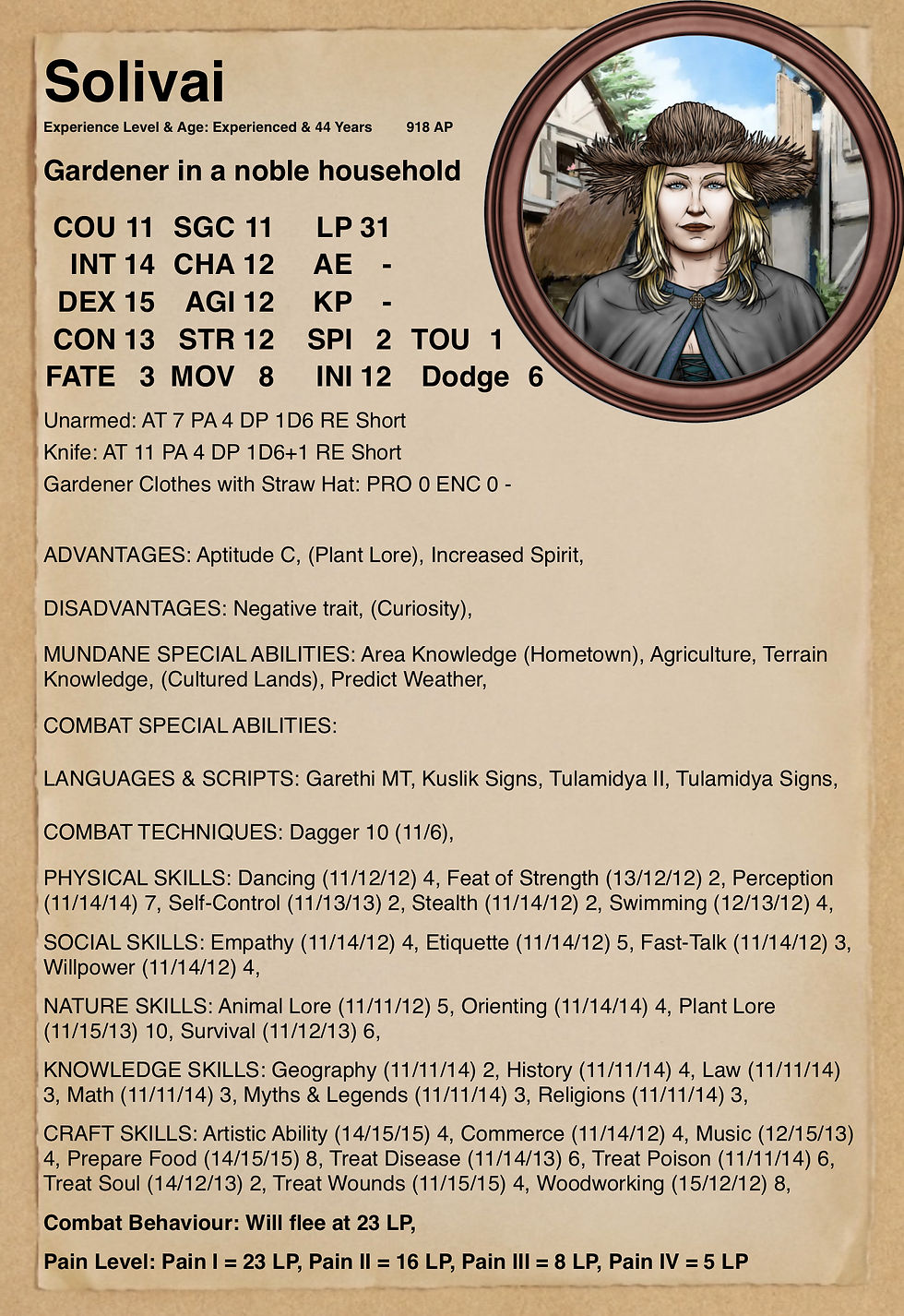Silent Takedowns
- Alisdair Smith

- Dec 3, 2022
- 4 min read
Some Background
When running The Dark Eye, one of my players has made a half elf mercenary that prefers to work through stealth, he's probably somewhere between an assassin and rogue. In a recent session the party had been tasked to investigate a camp of robbers and they managed to get close without being noticed, naturally the half elf wished to take out sentries quietly.
At the time I winged it, which was okay, but it got me interested in the idea of if the game supported it through any official rules. After some ivestigtion I learned that there are no published english rules to quickly and quietly take out an unaware target. Understandable, it isn't necessarily something you need in all games, and many games such as D&D don't really support it well anymore either.
My other favourite RPG is RuneQuest, and that game does support knocking people out, and its base combat system is deadly enough that hitting someone in the head with a weapon that they can't react to is likely to kill them anyway.
I spread my search wider and discovered that there are optional rules available in Compendium 2 (only available in german), found here
The Problem
I looked them over and they had some issues:
They're complicated, and felt unnecessarily so.
They're far too good, to an extreme that you may as well not bother
They don't really feel like they particularly reward a character for investing in being good at stealth, which should be an important factor in this.
That said, they ARE official, and I encourage you to make your own decision on them. If, like me, they aren't to your taste, please consider giving the following a go.
Backstab and Stun (alternative)
Optional rule
Can only be executed with the following combat techniques: daggers, fencing weapons, impact weapons, chain weapons, brawling, swords, polearms, two-handed impact weapons, two-handed swords, crossbows, bows, thrown weapons. The target must be in the medium or smaller size category.
A hero can backstab or stun anyone without fate points as long as long as the target moved no more than 4 yards and aren’t in combat. To do this, they must approach their victim unnoticed by succeeding on an opposed Stealth vs. Perception (Detect Ambushes or Sight) test, which automatically places the hero in Advantageous Position (see Rules, page 238 ) and imposes the Surprised status on the target.
Backstab
If the hero wants to backstab the victim, the characters damage total is multiplied by 1+ the QL they won the opposed Stealth Check by with a modifier determined by the Combat Technique used (minimum of x1).
Combat Technique | Modifier |
Brawling, Daggers | 0 |
Fencing weapons, Swords, Bows | -1 |
Impact weapons, Crossbows, Thrown Weapons | -2 |
All other techniques | -3 |
Basic manoeuvres, special manoeuvres, and passive combat skills cannot be used in Backstab, with the exception of Precise Strike. The final damage is still reduced by the targets PRO as normal.
e.g. Carolan attempts a backstab on a sentry, Carolan makes a stealth check with QL3, the sentry fails their Perception check - Carolan is able to attempt the attack.
Carolan gets +2 to their AT due to Advantageous Position and the sentry cannot defend due to Surprise.
Carolan rolls 15 for the attack which normally would be a failure but is just enough thanks to Advantageous position.
Carolan normally deals 1d6+2 and rolls 5 for a total of 7, but now gets to multiply the result by 4 (QL3+1, no negatives as daggers are short weapons). Dealing 28 damage, enough to take the sentry down quietly.
e.g. Igruvius attempts a backstab on a using his Mage staff sentry, Igruvius makes a stealth check with QL2, the sentry fails their Perception check - Igruvius is able to attempt the attack.
Igeuvius gets +2 to their AT due to Advantageous Position and the sentry cannot defend due to Surprise.
Igruvius rolls 10 for the attack, successfully hitting.
Igruvius normally deals 1d6+2 qith their 2 handed mage staff and rolls 4 for a total of 6, and only gets to multiply the result by 1 (QL2-3, -3 due to polearms, minimum multiplier of 1). Dealing just the original 6 damage and alerting the guard.
Stun
If the hero wants to stun the victim, the character deals half damage* and the target must make a Self-Control (Stay Conscious) test and compare the QL to the damage dealt, suffering 1 level of Stupor for ever point damage dealt beyond the QL achieved. The damage is reduced by the targets PRO as normal, but only after determining levels of Stupor. If the target suffers enough Stupor to become Unconscious, this lasts for 10 - (CON/2) minutes.
Basic manoeuvres, special manoeuvres, and passive combat skills cannot be used in Stun, with the exception of Sunning Blow, which automatically increases the level of Stupor by 1.
Stun is viable with all of the above combat techniques except ranged combat techniques.
Weapons that grant a bonus to damage for Stunning Blow also deal additional damage for this action (e.g. a club)
e.g. Carolan attempts a stun on a sentry using a club, Carolan makes a stealth check with QL4, the sentry gets QL1 on the Perception check - Carolan is able to attempt the attack.
Carolan gets +2 to their AT due to Advantageous Position and the sentry cannot defend due to Surprise.
Carolan rolls 10 for the attack, a hit.
Carolan normally deals 1d6+3 and rolls 5 for a total of 8, but now halves the damage, therefore dealing 4 damage.
The Sentry rolls their Self-Control (Stay Conscious) and gets QL2, not enough to negate levels of stupor entirely. Therefore the target suffers 3 levels of stupor (2 from the check +1 due to the advantage of the club)




Comments